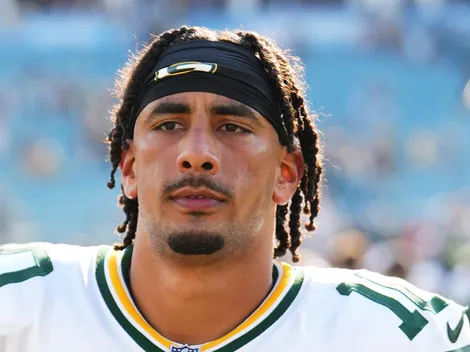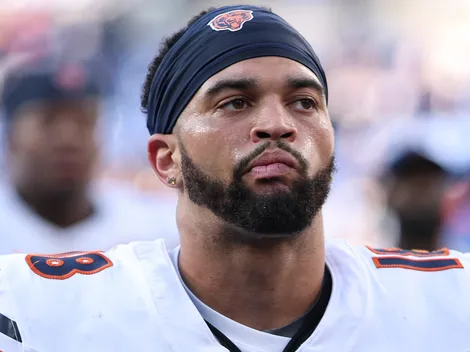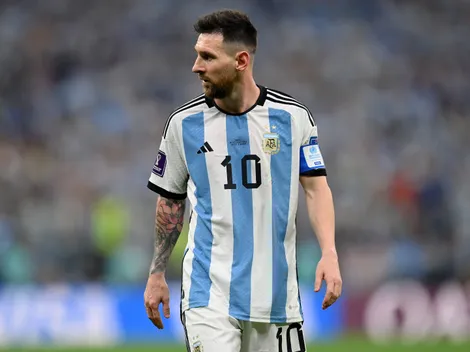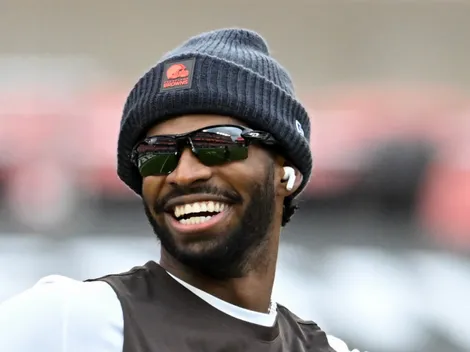You’ll often hear the adage that the NFL Draft is more of an art than a science. After all, you have to combine a bunch of empirical data (like a player’s height, weight, speed, and strength) with a lot of totally subjective observations (game film, playing style, college scheme), and then use all of that to determine how that player will fare several years from now.
That’s why guys like Carlos Rogers somehow end up being drafted ahead of guys like Aaron Rodgers (2005 NFL Draft). That made us want to go back and look through each NFL Draft and determine every team’s most painful draft regret while also revisiting who they would have been better off taking instead. In a way, our list is the cross-section of draft busts and draft steals while allowing us to second-guess every team’s most questionable draft choice.
San Francisco 49ers Drafted: Giovanni Carmazzi (2000)

(Getty Images)
After Steve Young retired, the 49ers went about the process of finding their next great franchise quarterback. Admittedly, that was going to be tough after they had such profound success with Young and Joe Montana before him. They were convinced that Giovanni Carmazzi, the little-known but super-athletic prospect from tiny Hofstra University, would be that guy. San Francisco took him early in the third round of the draft, making him the second quarterback who was selected in that class.
Could Have Drafted: Tom Brady

(Getty Images)
History tells us that they should have taken the guy from Northern California, who grew up idolizing Joe Montana and was still available in the 6th round of that same draft. Of course, that guy was none other than Tom Brady, who might have surpassed Montana as the greatest quarterback of all time while playing for the 49ers.
Can you imagine Montana, Young, and Brady all playing for the same franchise with almost no interval in between? It’s almost hard to fathom but wouldn’t have been that shocking for a franchise like the 49ers.
Houston Texans Drafted: David Carr (2002)

(Getty Images)
Throughout the 2001 college football season, there was no question that defensive end Julius Peppers from the University of North Carolina was the best player in the nation and should be the no. 1 pick in the NFL Draft. But as the draft process approached, quarterback David Carr began shooting up the draft boards. With the Houston Texans making their first draft selection in franchise history, it made sense to start with a quarterback, leading them to take a chance on Carr.
Could Have Drafted: Julius Peppers

(Getty Images)
Carr would spend his career in Houston getting absolutely battered behind a terrible offensive line, so his lack of success wasn’t entirely his fault. Meanwhile, Peppers thrived for the Panthers, who pounced on him with the second-overall pick after Houston passed on him.
Peppers finished six seasons with double-digit sacks during his eight years in Carolina and eventually went to nine Pro Bowls during his incredible career. The Texans surely could have used Peppers to build an elite defense early in their history rather than setting up a young quarterback for failure.
New England Patriots Drafted: Tony Eason (1983)

(Getty Images)
The New England Patriots are one of several teams that infamously passed on Dan Marino in the famed 1983 NFL Draft. Instead of Marino, the Patriots took quarterback Tony Eason from Illinois.
They took Eason despite the fact that head coach Raymond Berry knew that Eason was too frail to hold up against the brutality of playing quarterback in the NFL (especially in the 1980s). He’s the only quarterback in NFL history to start a Super Bowl and not complete a pass in the game, which happened in New England’s 46-10 loss to the Bears in Super Bowl XX.
Could Have Drafted: Dan Marino

(Getty Images)
Eason might’ve led the Patriots to a Super Bowl in his third year, but as we all know, Marino rewrote the record books in his second year, leading the Miami Dolphins to a Super Bowl the year before.
While Marino never won a Super Bowl in his career, who’s to say he couldn’t have done so in New England? Perhaps he could have found success with another AFC East team and not make the Patriots wait for Tom Brady to come along to win a championship. After all, Marino would have been a success just about anywhere.
Washington Commanders Drafted: Carlos Rogers (2005)

(Getty Images)
To be clear, 23 teams passed on Aaron Rodgers in the 2005 NFL Draft, including the San Francisco 49ers, who took another quarterback at no.
1 overall. But Washington needed a quarterback entering the draft and ended up taking quarterback Jason Campbell later on in the first round. They also could have taken Rodgers with the no. 9 overall pick but passed on a quarterback completely so they could draft cornerback Carlos Rogers out of Auburn.
Could Have Drafted: Aaron Rodgers

(Getty Images)
Rogers was a solid cornerback for the Redskins. But fans started calling him stone hands Rogers for his penchant for dropping potential interceptions. Meanwhile, fans in Green Bay are busy calling Rodgers The GOAT. The four-time MVP could have been Washington’s franchise quarterback and completely changed the way we look at the NFC East.
During the time Rodgers has been in the league, RG3 and Kirk Cousins are the closest things Washington has had to a franchise quarterback.
Jacksonville Jaguars Drafted: Blaine Gabbert (2011)

(Getty Images)
It’s not just the fact that the Jaguars drafted quarterback Blaine Gabbert with the 10th overall pick in the 2011 NFL Draft, one spot ahead of where their division rivals (the Houston Texans) would grab a defensive end that’s bound of the Hall of Fame (J.J. Watt).
It’s also the fact that the Jaguars traded up to the 10th overall pick from the 17th overall pick (surrendering a second-round pick to move up that far) and then still took the guy who would turn out to be an enormous draft bust.
Could Have Drafted: J.J. Watt

(Getty Images)
Jacksonville’s loss turned out to be Houston’s gain, obviously. Watt is one of only two players in NFL history to win the NFL Defensive Player of the Year award three times. He also collected over 20 sacks in two separate seasons. On top of his performance on the field, Watt has always been a great ambassador for the Texans and the NFL.
To be fair, the teams that drafted 1-6 in 2011 should all be happy with their pick. But the teams with the 7-10 spots, especially the Jags, should regret not taking Watt.
Kansas City Chiefs Drafted: Todd Blackledge (1983)

(Getty Images)
The 1983 NFL Draft was one of the most memorable in history, given the fact that six Hall of Fame players were taken in the first round. It was also the first time five quarterbacks were taken in the first round. When the Chiefs were on the clock at no. 7 overall, everyone knew they were going to take a quarterback but assumed it would be either Jim Kelly or Dan Marino.
But they threw a curveball by drafting Todd Blackledge from Penn State (who himself was surprised the Chiefs took him so early). Blackledge played only five seasons with the Chiefs and was frequently benched.
Could Have Drafted: Dan Marino

(Getty Images)
Marino, as we all know, turned out to be one of the most prolific quarterbacks in NFL history. He’s arguably the best player of all time who never won a Super Bowl. It’s possible that Marino would have been able to lead Kansas City to a Super Bowl during the time that Blackledge struggled. Keep in mind that some of Marino’s best seasons were early in his career.
If nothing else, the Chiefs surely would have won more than two playoff games between the 1983 Draft and the 2015 season if they had taken Marino.
Los Angeles Chargers Drafted: Ryan Leaf (1998)

(Getty Images)
When the Colts took Peyton Manning with the no. 1 overall pick in the 1998 NFL Draft, the Chargers believed they were going to get the chance to draft the better quarterback at no. 2 overall. Of course, we all know that belief couldn’t be more wrong. Leaf was not betting than Manning, nor was he better than Charlie Batch, Brian Griese, or Matt Hasselbeck, who were all selected later in the draft.
If the Chargers had known Leaf would become one of the biggest busts of all time, they likely would have gone another route.
Could Have Drafted: Charles Woodson

(Getty Images)
Instead, that mistake is only compounded by the fact that the Chargers passed on Woodson. The legendary cornerback remains the only defensive player to win the Heisman, so it wouldn’t have been a stretch to pick him no.
2 overall rather than giving the Raiders a chance to draft him fourth overall. In fairness, the Chargers needed a quarterback at that point. But outside of Manning, there’s nobody who would have been able to turn the franchise around. Woodson, on the other hand, could have been a fixture on their defense for years to come.
Los Angeles Rams Drafted: Lawrence Phillips (1996)

(Getty Images)
Head coach Dick Vermeil is always going to be a beloved figure in the history of the Rams franchise. But his Super Bowl win helps people forget what a huge mistake he made early on with Phillips.
Vermeil believed he could guide the highly-troubled running back on the straight and narrow, leading him to draft Lawrence with the 6th overall pick in the 1996 NFL Draft despite the fact that many teams had Phillips off their board entirely (and for good reason, as it turns out).
Could Have Drafted: Ray Lewis

(Getty Images)
Towards the back end of the first round, the Ravens stole an undersized but energetic linebacker named Ray Lewis, who became a Hall of Famer.
After a career that included 13 Pro Bowl selections and nine All-Pro selections, Lewis is one of the best linebackers of all time. Even with two other Hall of Famers selected in the 1996 Draft, Lewis may have been the best player in the class. In retrospect, the Rams and anyone else drafting before the no. 26 spot where the Ravens got him should have taken Lewis.
Miami Dolphins Drafted: Ted Ginn (2007)

(Getty Images)
In a 2007 NFL Draft that saw six Pro Bowl players taken among the top 12 picks, the Dolphins raised eyebrows all over the league when they reached for Ginn, a wide receiver from Ohio State. Everyone knew that Ginn was a world-class athlete with incredible speed. But almost everyone knew that he had a lot of work to do as a receiver.
Could Have Drafted: Darrell Revis
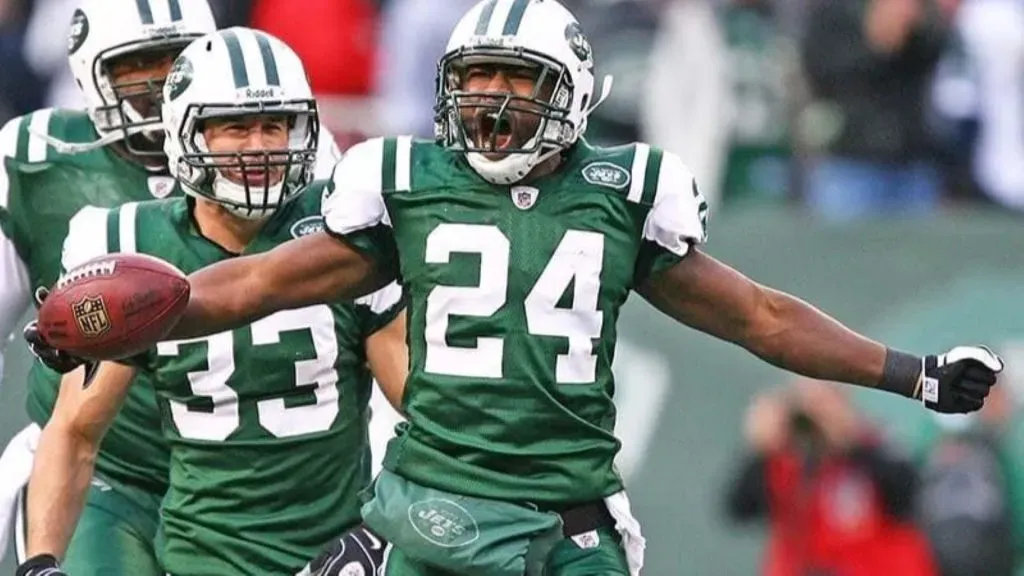
(Getty Images)
To make matters worse, five picks after Ginn was taken, the division rival Jets selected Revis. The cornerback quickly became the best at his position in the NFL, and one of the true shutdown cornerbacks of this era.
Conversely, the Dolphins dumped Ginn after only three seasons. Plus, Revis played with the Jets for six seasons, which meant six years and two games per season of Miami’s subpar wide receivers contributing very little while being defended by Revis.
Indianapolis Colts Drafted: John Elway (1983)

(Getty Images)
One of the most infamous Draft day stories in NFL history. The then Baltimore Colts, with the no. 1 pick in the famous 1983 NFL Draft, took Elway with the top pick despite his public stance that he’d never play for the Colts.
But owner Robert Irsay was stubborn, drafting Elway, only to commandeer a trade that earned them pennies on the dollar, sending him to Denver (when there were certainly better offers on the table from other teams).
Could Have Drafted: Dan Marino

(Getty Images)
While everyone agreed that Elway was the best player in the draft, if the Colts wanted to take a quarterback, they could’ve taken Marino. The Dolphins picked him up after he fell all the way to no.
27 overall. Nobody knows if Marino could have won a Super Bowl with the Colts after failing to do so with the Dolphins throughout his entire career. But the Colts at least would have had a fighting chance with Marino rather than wasting a pick on somebody who told them he didn’t want to be there.
New Orleans Saints Drafted: Russell Erxleben (1979)
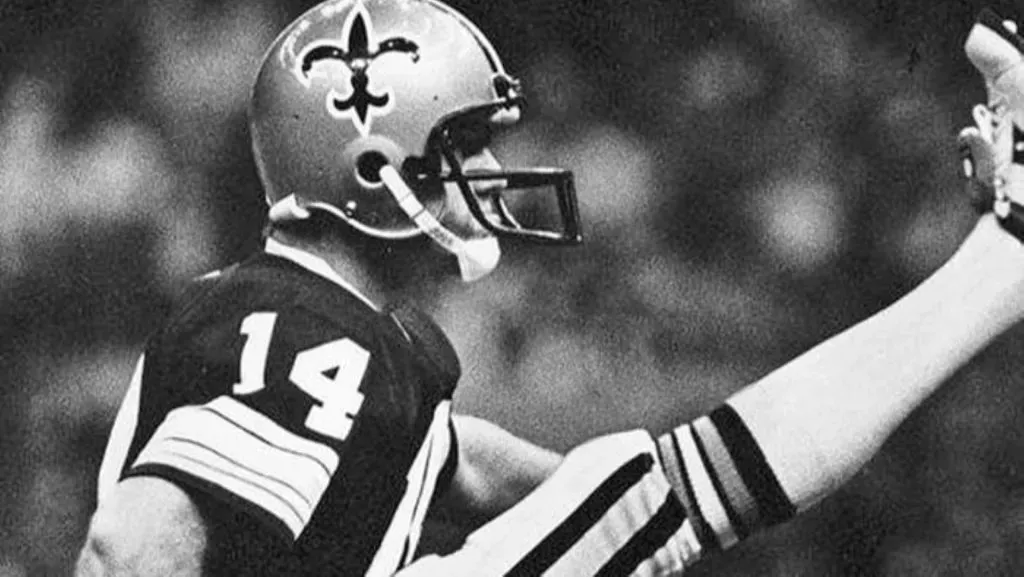
(Getty Images)
Erxleben might be the sole reason an NFL team will never take a punter in the first round of the NFL Draft. Well, there are probably a few more good reasons as well.
The Saints were apparently enamored with the three-time All-American from Texas, enough so to make him the 11th overall pick in the 1979 NFL Draft (which even shocked Erxleben). The Saints tried Erxleben at punter and kicker, which went as well as you might imagine.
Could Have Drafted: Kellen Winslow Sr.

(Getty Images)
The pick looks even more egregious in hindsight, considering the Chargers selected tight end Kellen Winslow just two picks later. The elder Winslow (not to be confused with his son) was one of the greatest tight ends in NFL history and a Hall of Famer.
Quarterbacks like Archie Manning and Ken Stabler would have been far better off with Winslow as an option. Frankly, most players in that class would have been a better choice than Erxleben.
New York Jets Drafted: Johnny Lam Jones (1980)

(Getty Images)
During the 1980 NFL Draft, the Jets traded two first-round picks to move up to the no. 2 overall spot to take Jones, a wide receiver from Texas.
He was fast enough to compete on the 4×100 relay team for the United States at the 1976 Summer Olympics. The problem is that while Jones could run as fast as the wind, he couldn’t catch worth a lick. In five seasons, he had a grand total of five touchdowns.
Could Have Drafted: Anthony Munoz

(Getty Images)
In taking Jones, the Jets passed on Munoz, a Hall of Famer who is arguably the best offensive lineman of all time. Instead, the Bengals were able to select Munoz with the very next pick. Obviously, offensive linemen aren’t considered sexy picks. But the Bengals surely don’t regret taking Munoz for one second.
Oakland Raiders Drafted: Jamarcus Russell (2007)

(Getty Images)
In a draft that saw two of the most dominant offensive players of the past decade, the Raiders ended up with one of the biggest draft busts since the turn of the century. In fairness to the Raiders, there were draft analysts who gushed about the workouts put on by Russell, who seemed to have the physical tools of a star quarterback.
Some even dared to compare him to John Elway. But Russell’s lack of polish and total lack of worth ethic submarined his career before it ever started.
Could Have Drafted: Calvin Johnson

(Getty Images)
With the second overall pick — right after Russell was taken no. 1 overall — the Lions took Johnson and didn’t regret it for a second until the day he retired. Johnson earned the nickname Megatron because he was an athletic freak who caught everything. In fairness, Johnson wouldn’t have had a quarterback to throw him the ball if he had been drafted by the Raiders.
Then again, anyone who could get the ball anywhere near Johnson would have had success throwing the ball to Megatron, at least more success than Russell ever had.
Philadelphia Eagles Drafted: Mike Mamula (1995)

(Getty Images)
If you look up the definition of workout warrior in the dictionary, you’ll likely find a picture of former Mike Mamula. The Eagles were tantalized – like so many other teams in the league – by Mamula’s workouts at the NFL Combine, overlooking the fact that the defensive end wasn’t actually that good of a football player.
Needless to say, that became obvious sooner rather than later.
Could Have Drafted: Warren Sapp

(Getty Images)
Instead of taking Mamula, Sapp would have been a far better option for the Eagles if they wanted to address their defensive line. But while Philly ended up wasting the no.
7 overall pick on Mamula, Sapp was still available until pick no. 12 when the Bucs grabbed him. He would go on to have a Hall of Fame career with Tampa. Sapp went to the Pro Bowl seven times, won Defensive Player of the Year in 1999, and helped the Buccaneers to win a Super Bowl. The only question is if he would have looked as good doing those things in green.
Pittsburgh Steelers Drafted: Gabe Rivera (1983)

(Getty Images)
When Dan Marino was sliding down in the first round of the 1983 NFL Draft, the Steelers debated selecting Marino 21st overall to become the heir apparent to Terry Bradshaw. The Steelers weren’t spooked by the rumors of Marino being a drug user (which were proven totally false) but decided to stick to their organization’s MO and take their favorite defensive player in the draft.
That player was Rivera, a defensive tackle from Texas Tech. But in his rookie season, Rivera was involved in a horrific car accident that left him paralyzed, making this a case of bad fortune rather than a bad pick.
Could Have Drafted: Dan Marino

(Getty Images)
In 2022, the Steelers drafted Kenny Pickett, who played his college football for the Pitt Panthers. Why didn’t the Steelers do the same thing with Marino, who also played at Pitt?
It would have been so easy. Instead, the quarterback position became a virtual black hole for the Steelers during the 80s after Bradshaw retired. What were they thinking not believing that Marino would have been the perfect fit to take the reins?
Cleveland Browns Drafted: William Green (2002)

(Getty Images)
If the Browns have been consistently good at anything since coming back to the NFL in 1999, it’s been making bad choices in the NFL Draft. For instance, in the 2002 NFL Draft, the Browns made Green, a running back from Boston College, the 16th overall pick. But between injuries and a bizarre off-the-field incident, Green never had more than 900 yards rushing in any season.
While Green is nowhere near the biggest bust the Browns ever drafted (Courtney Brown, Johnny Manziel, Justin Gilbert, etc), he’s on this list due largely to the fact that the Browns selected him and passed up one the best defensive players in NFL history.
Could Have Drafted: Ed Reed

(Getty Images)
Eight picks after the Browns took Green off the board, the Ravens took Reed. To date, he’s the only member of the 2002 draft class in the Hall of Fame.
Not only did the Browns miss out on drafting him but they also had to play against him for more than a decade. During that time, Reed went to nine Pro Bowls and became one of the best safeties in NFL history.
Seattle Seahawks Drafted: Aaron Curry (2009)

(Getty Images)
When the Seahawks used the 4th overall pick on Curry, nobody second-guessed taking the standout linebacker from Wake Forest. Anyone who watched Curry gushed about his athletic ability for a guy his size (he was 255 lbs), envisioning him as the ultimate chess piece on defense.
But Curry admitted to losing all of his motivation once he signed one of the richest rookie deals in NFL history.
Could Have Drafted: Clay Mathews III

(Getty Images)
If the Seahawks wanted a linebacker who would play like his hair was on fire every down, they could have instead taken Matthews. He was available at the time and lasted until the Packers selected him 22 picks after Curry at no.
26 overall. As the son and nephew of former NFL players, Matthews had quite the career himself. He went to six Pro Bowls during his decade in Green Bay and racked up 91.5 sacks in his career.
Denver Broncos Drafted: Tim Tebow (2010)

(Getty Images)
While every NFL Draft analyst spent the spring shouting from the rooftops that Tebow shouldn’t be drafted as a quarterback, the Broncos – under head coach Josh McDaniels – threw all that advice to the wind and took Tebow anyway.
While Tebow did lead the Broncos to the playoffs and a memorable playoff win over the Steelers, it was clear that he wasn’t going to be a long-term solution. Ultimately, they were able to replace him with Peyton Manning and win another Super Bowl, but there’s no denying it was a huge mistake taking Tebow in the first round.
Could Have Drafted: Devin McCourty

(Getty Images)
Two picks after Tebow was taken, the Patriots – McDaniels’ former team – took McCourty. After entering the league as a cornerback, McCourty became of the best safeties in the NFL during his tenure in New England.
He was a part of three teams that won the Super Bowl and was named a Second-Team All-Pro three times. Plus, more than a decade after the peak of Tebow’s NFL career, McCourty is still in the league.
Tampa Bay Buccaneers Drafted: Mark Barron (2012)

(Getty Images)
Usually, you can’t go wrong picking a guy who played defense under Nick Saban at Alabama. But when the Buccaneers took Barron with the no. 7 overall pick in the 2012 NFL Draft, they tried to jam a square peg into a round hole. Barron was a big safety who excelled around the line of scrimmage.
He didn’t fit into a Cover 2 scheme that forced him to play in coverage. Essentially they drafted Barron for the wrong reasons.
Could Have Drafted: Luke Kuechly

(Getty Images)
In taking Baron, the Buccaneers passed on the guy who could’ve had the type of career in Tampa that Derrick Brooks had. That player was Kuechly, who the Panthers grabbed two picks after the Bucs settled on Barron.
Kuechly won Defensive Rookie of the Year honors in 2012 and Defensive Player of the Year in 2013. He was a Pro Bowler in all but his rookie season, becoming arguably the best middle linebacker of the 2010s.
Detroit Lions Drafted: Charles Rogers (2002)

(Getty Images)
In the spring of 2003, Lions CEO Matt Millen envisioned Joey Harrington and Rogers as the next dominant QB-WR duo in the NFL. Millen’s Lions took Rogers with the no.
2 pick in 2003, a year after picking Harrington. But like Harrington, Rogers turned out to be a colossal bust who simply wasn’t ready to play in the NFL and couldn’t stay healthy.
Could Have Drafted: Andre Johnson

(Getty Images)
Unfortunately, the Lions could have easily had Johnson instead of Rogers. The former Miami Hurricanes standout was selected by the Texans one pick after the Lions took Rogers.
Johnson went on to have an exceptional NFL career, putting himself among the best wide receivers of all time. In 14 seasons, he went to the Pro Bowl seven times, including the 2008 season when he led the league in both receptions and receiving yards.
Tennessee Titans Drafted: Andre Woolfolk (2003)
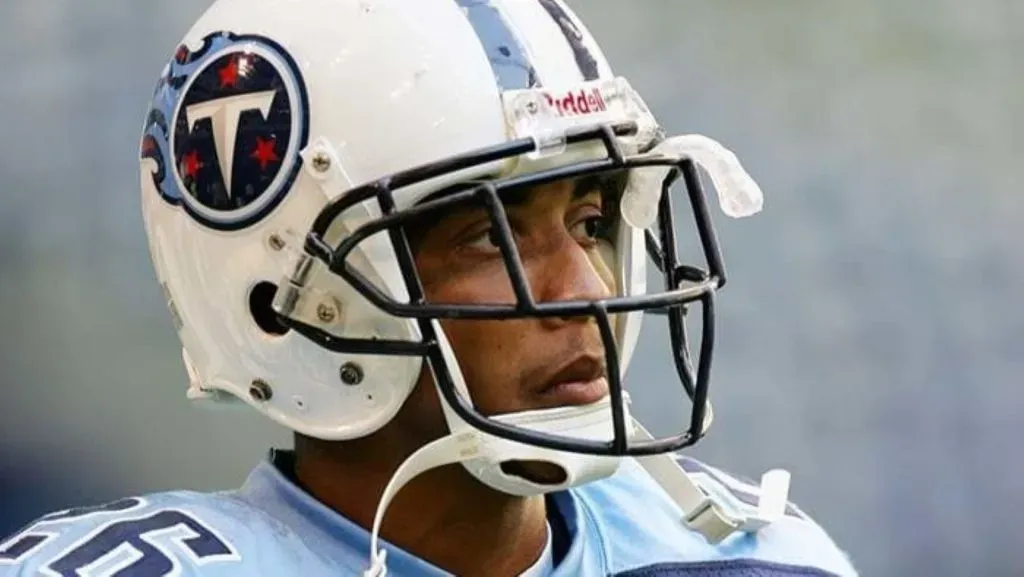
(Getty Images)
Late in the First Round of the 2003 NFL Draft, the Titans selected Woolfolk, a cornerback from Oklahoma. He had a good resume coming out of college but never made it in the pros.
How forgettable was he? In four NFL seasons, he had three interceptions. In fact, all three of them were thrown by another draft bust, David Carr of the Texans.
Could Have Drafted: Nnamdi Asomugha
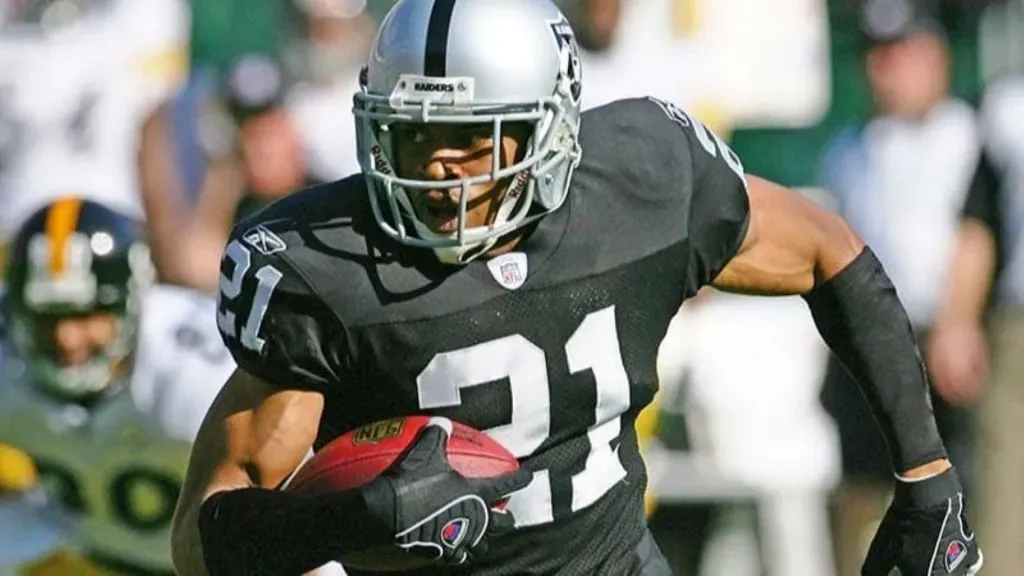
(Getty Images)
Tennessee has to be kicking itself by taking Woolfolk when it could have taken Asomugha. With the 31st overall pick, the Raiders made Asomugha the fifth cornerback selected in the 2003 Draft.
Despite two other Pro Bowlers (Terence Newman and Marcus Trufant) being among that group, Asomugha was arguably the best of the bunch. He went to the Pro Bowl three times in more than a decade in the league and was among the elite corners in the league for a few years.
Arizona Cardinals Drafted: Kelly Stouffer (1987)
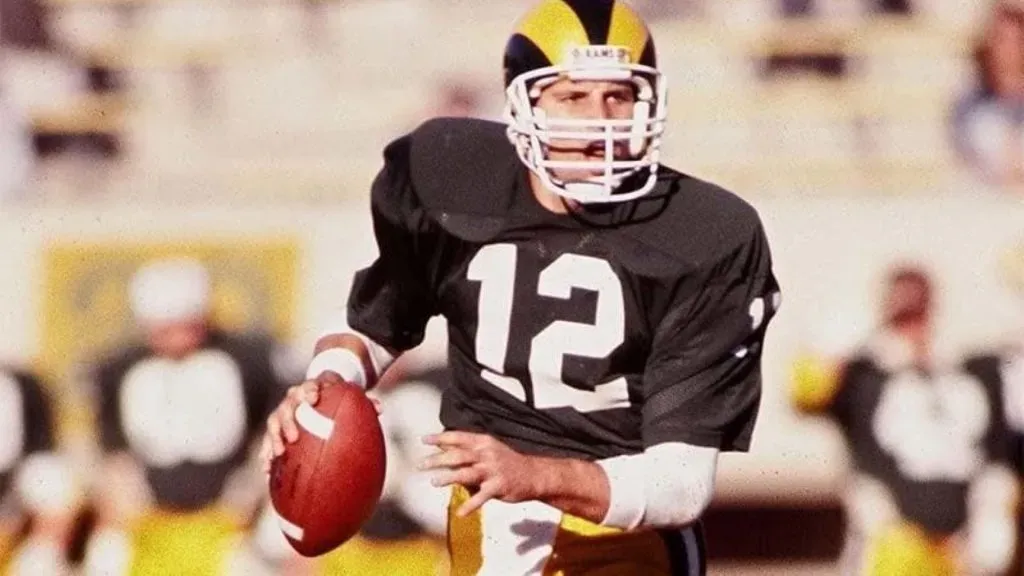
(Getty Images)
They tend to get omitted from the discussion because of the stability they’ve had in recent years, but the Cardinals franchise saw a revolving door of quarterbacks for much of the 1990s and the first part of the 2000s. Those quarterback problems all started when the franchise drafted Stouffer, who was supposed to be the heir apparent to Neil Lomax, in the 1987 NFL Draft.
Stouffer was drafted no. 6 overall and missed his entire rookie season due to a contract holdout. Thanks to the holdout, Stouffer never actually played for the Cardinals before he was traded to the Seahawks, making the pick a complete waste.
Could Have Drafted: Rod Woodson

(Getty Images)
Meanwhile, four picks after Stouffer was taken, the Steelers selected Woodson, an All-American defensive back from Purdue University. When all was said and done, Woodson would be one of the best cornerbacks of all time, not to mention a top-notch safety later in his career.
If they were a little smarter, the Cardinals could have had an 11-time Pro Bowler and the all-time leader in interceptions returned for a touchdown. Of course, Woodson is also in the Hall of Fame and a legendary figure in NFL history.
Atlanta Falcons Drafted: Aundray Bruce (1988)
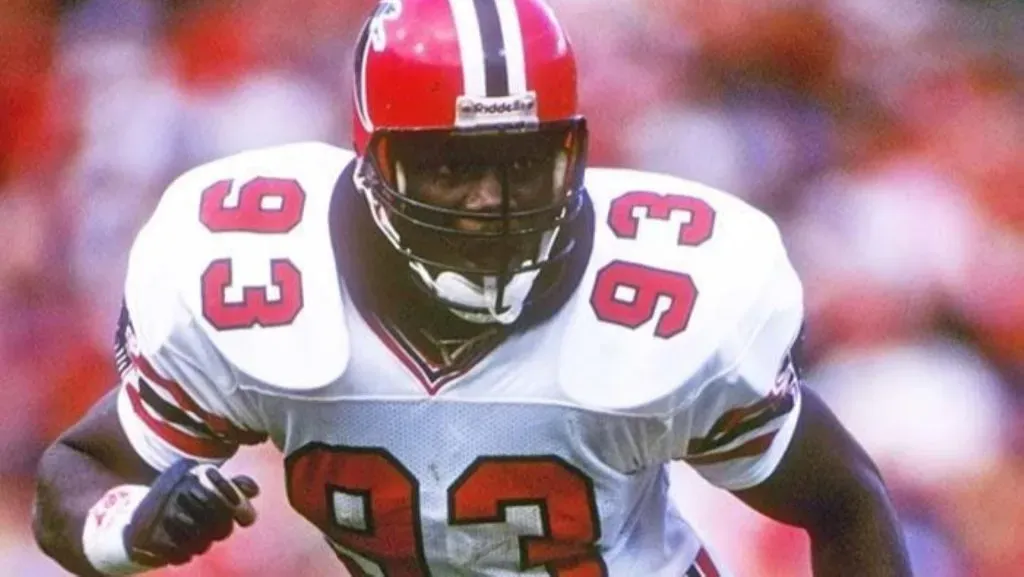
(Getty Images)
In the 1988 NFL Draft, 11 of the first 15 players selected were named to a Pro Bowl at some point in their career, including two players who ended up in the Hall of Fame. Yet, despite having the first overall pick in that draft, the Falcons walked out of that draft with none of those players. Atlanta selected Bruce, a linebacker out of Auburn, with the no.
1 overall pick. But four years later, the Falcons were content to let Bruce leave via free agency after 16 sacks in his first three seasons and none in his fourth and final season in Atlanta.
Could Have Drafted: Tim Brown

(Getty Images)
Six picks after Bruce was taken, Al Davis and the Raiders selected Brown out of Notre Dame. At the time, he was the reigning Heisman winner, and he more than lived up to that in the NFL. After an incredible 16-year NFL career, Brown became one of those two guys from the top of the 1988 NFL Draft who made it to Canton.
Looking back, it’s hard to believe anybody passed on Brown. But it’s particularly hard on the Falcons, who are one of the few teams with an absolute bust in the first half of the 1988 Draft.
Baltimore Ravens Drafted: Mark Clayton (2005)

(Getty Images)
Baltimore’s struggles on offense in the early 2000s weren’t exclusive to the quarterback position. After seeing seven different players lead the team over their first nine seasons as a franchise, the Ravens tried to find a standout wide receiver, selecting Clayton with the 22nd overall pick in the 2005 NFL Draft.
But Clayton didn’t fare much better than any of the guys they already had. He failed to eclipse more than 940 yards or five receiving touchdowns during his five years in Baltimore.
Could Have Drafted: Roddy White

(Getty Images)
After Clayton, the next receiver selected was White. While he was somewhat easy to overlook, coming out of UAB, White made the teams that passed on him regret it, especially the Ravens.
He played 11 seasons in the league and became one of the most consistent receivers in the NFL. White had six straight seasons with 1,000 yards receiving as a member of the Falcons and went to four straight Pro Bowls during the prime of his career.
Buffalo Bills Drafted: Mike Williams (2002)

(Getty Images)
As an All-American at Texas, Williams leapfrogged fellow All-American Bryant McKinnie as the first tackle taken in the 2002 NFL Draft. But the 6’7, 337-pound behemoth struggled upon entering the NFL.
He failed at both the right and left tackle spots early on in his career. Four years after he was drafted, and after a failed attempt to convert him to defensive tackle, the Bills released Williams.
Could Have Drafted: Bryant McKinnie

(Getty Images)
McKinnie ended up going three picks after Williams. While he didn’t blossom into a superstar either, he did go to one Pro Bowl. More importantly, he came much closer to living up to the hype of being a top-10 pick than Williams.
If nothing else, he was solid, playing 12 seasons and starting 162 games, which is no small feat for an offensive lineman.
New York Giants Drafted: Ron Dayne (2000)

(Getty Images)
Still trying to recapture their glory days under Bill Parcells when they’d smash opponents with a power running game, the New York Giants drafted running back Ron Dayne with the 11th overall pick in the 2000 NFL Draft.
The Great Dayne, as he was nicknamed, won the Heisman Trophy at Wisconsin after setting the NCAA record for most rushing yards in a season. But Dayne struggled with his weight in the NFL and never came close to fulfilling his lofty draft selection.
Could Have Drafted: Shaun Alexander
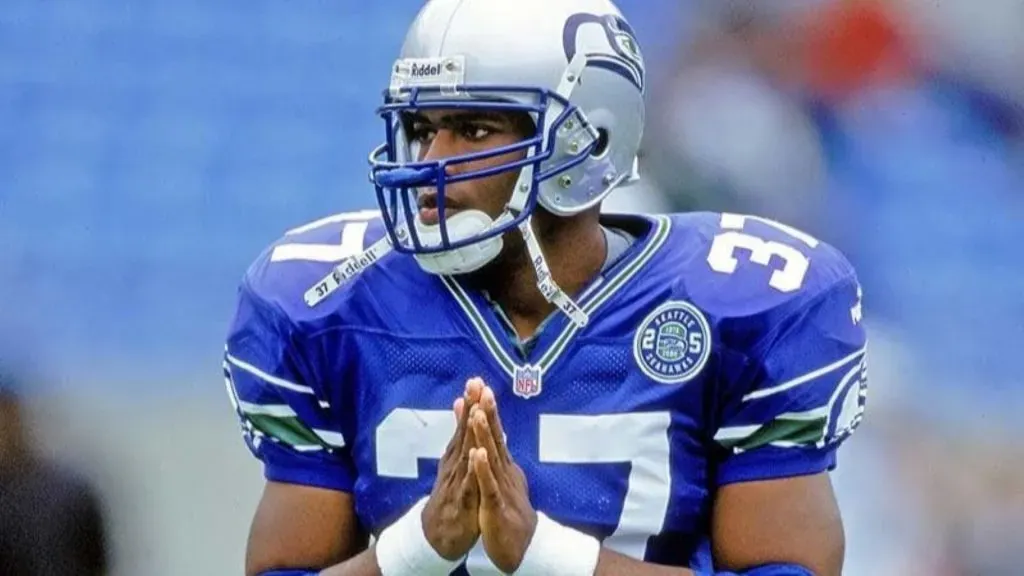
(Getty Images)
In taking Dayne, New York passed on running back Shaun Alexander, whom the Seattle Seahawks took eight picks later. Alexander set the single-season record for most rushing touchdowns in one year by piling up 27 scores during his MVP season in 2005.
He is exactly the type of back the Giants wanted when they drafted Dayne. Instead, the Seahawks got to watch Alexander lead the NFL in rushing yards twice while playing in Seattle.
Cincinnati Bengals Drafted: Jack Thompson (1979)

(Getty Images)
In the 1979 NFL Draft, the Bengals had two of the top 12 picks and managed to botch them both. First, they took Thompson, a quarterback from Washington State, third overall, and then running back Charles Alexander at no.
12 overall. Alexander had a few serviceable years in Cincinnati but Thompson turned out to be a huge bust. He completed fewer than 50% of his passes with more interceptions than touchdown passes and a 1-4 record as a starter.
Could Have Drafted: Dan Hampton

(Getty Images)
To make matters worse, one pick after the Bengals bungled the selection of Thompson, the Bears chose Hampton, a defensive tackle out of Arkansas. While Thompson was a bust, Hampton became a Hall of Famer.
He was an integral member of Chicago’s vaunted 46 Defense under the legendary Buddy Ryan. Despite having five surgeries on each of his knees, Hampton played 12 seasons but only missed 23 games, making him one of the best defensive tackles of the 80s.
Green Bay Packers Drafted: Tony Mandarich (1989)

(Getty Images)
It’s one thing to take a player who lives in infamy as one of the biggest draft busts of all time, but it’s an entirely different — and much worse — matter when you take said bust and miss out on the guy who would become one of the greatest players in NFL history.
In the 1989 NFL Draft, the Green Bay Packers selected offensive tackle Tony Mandarich, who everyone believed would be a generational player in the NFL.
Could Have Drafted: Barry Sanders

(Getty Images)
Unfortunately for the Packers, the generational player in that draft came one pick after Mandarich. It was Barry Sanders, who the Lions selected. Mandarich went down as an admitted user of steroids while Sanders went down as one of the greatest running backs in NFL history.
Of course, even Sanders could only do so much to elevate the Lions. But imagine if Sanders and Brett Favre played on the same team. Green Bay probably would have won more than one Super Bowl during the 90s.
Minnesota Vikings Drafted: Dimitrius Underwood (1999)
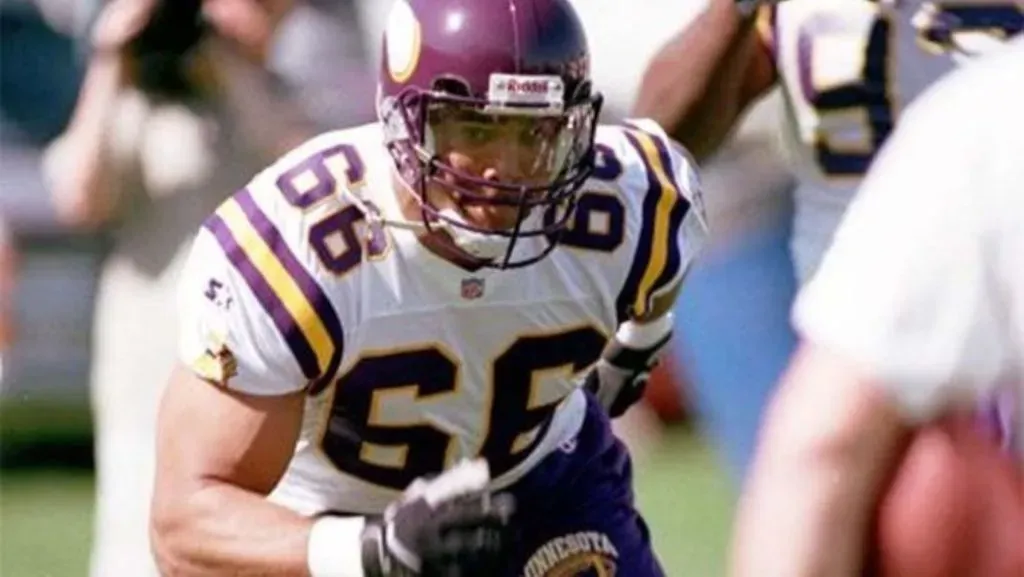
(Getty Images)
A year after selecting Randy Moss, head coach Dennis Green – clearly convinced of his ability to mentor troubled prospects – led the Vikings to select Underwood, a highly-troubled defensive lineman from Michigan State.
But literally after his first practice as a member of the Vikings, Underwood walked out, claiming the game conflicted with his Christian faith. There was no word on where his Christian faith was in September when he was arrested for failing to pay child support. Perhaps he shouldn’t have walked out on practice and been forced to return his $1.7 million signing bonus to the Vikings.
Could Have Drafted: Patrick Kerney
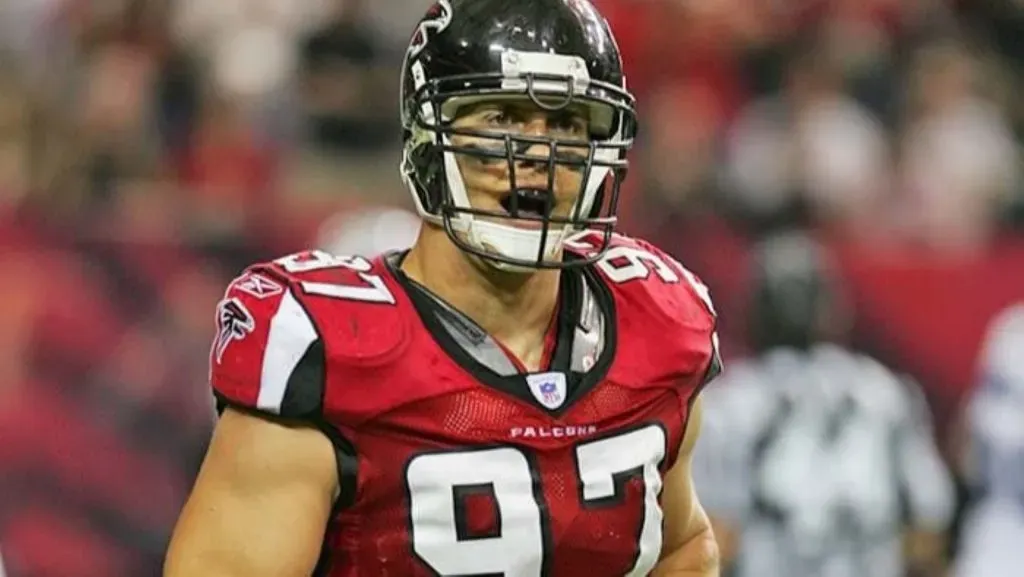
(Getty Images)
If the Vikings really wanted to upgrade their pass rush, they should’ve taken Kearney. He was chosen by the Falcons just one pick after the Vikings selected Underwood.
The clean-cut Kearney didn’t blossom into a superstar but he was a far more reliable player than Underwood. He made two Pro Bowls during his 11-year NFL career and never missed a game during his first seven years with the Falcons, collecting at least 10 sacks three times for Atlanta and once for the Seahawks later in his career. In short, Kerney is exactly the type of player you want to pick up late in the first round.
Dallas Cowboys Drafted: Greg Ellis (1998)

(Getty Images)
This is one of the best stories in recent NFL history for anyone who hates the Dallas Cowboys (and there are plenty of such people). After owner Jerry Jones promised Randy Moss that the Cowboys would pick him if he were available in the 1998 NFL Draft, the Cowboys got spooked by Moss’ checkered past (talk about irony).
Instead, they took defensive end Greg Ellis from North Carolina. Ellis was a fine defensive end for a number of years for the Cowboys, even being named to the Pro Bowl once.
Could Have Drafted: Randy Moss

(Getty Images)
To compare Ellis to Randy Moss is a total joke, considering Moss will go down as one of the greatest wide receivers of all time. In defense of the Cowboys, they thought they would have Michael Irvin for a few more years and didn’t know he would soon suffer an injury that would end his career earlier than expected.
Nevertheless, Moss would have been the perfect fit for the Cowboys had Jones stuck to his word. Imagine him and Irving together, even for just a short time.
Carolina Panthers Drafted: Tim Biakabutuka (1996)
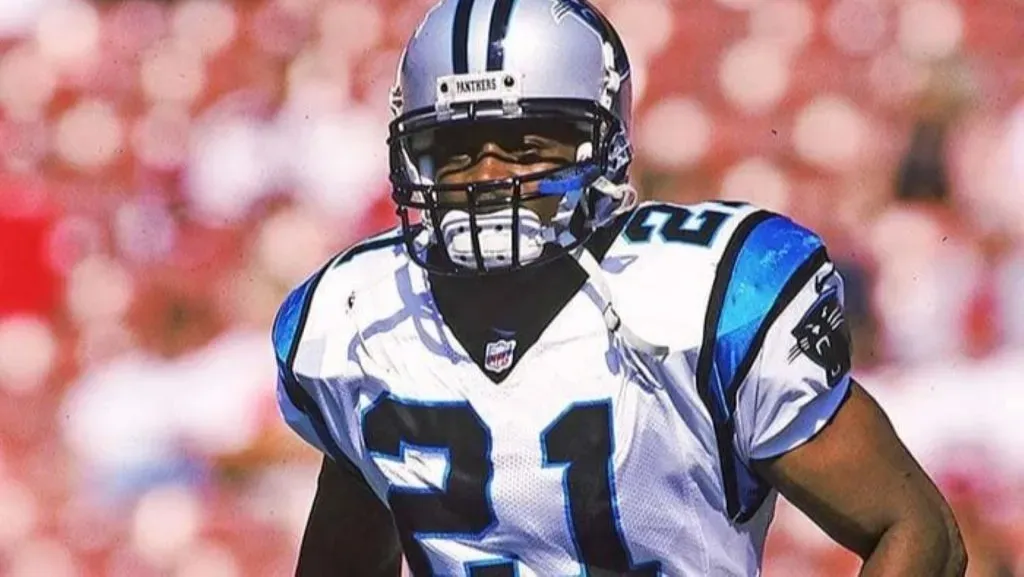
(Getty Images)
As life lessons tend to teach us, steady and reliable things are almost always better than flashy things. A great example of this is when the Panthers decided to take Biakabutuka, a running back from Michigan.
They thought he’d be a dynamic running back in the NFL, even passing on Heisman Trophy winner Eddie George. For what it’s worth, Biakabutuka did show a few flashes of brilliance. But they were in between a myriad of injuries. Despite playing in the NFL for six seasons, he ran for a grand total of 2,530 yards.
Could Have Drafted: Eddie George

(Getty Images)
Compared to George, who ran for over 10,000 yards over the course of his NFL career, Biakabutuka is a major bust despite George going six picks later. George may not be a Pro Football Hall of Famer but the Oilers/Titans got a lot of good years out of him. He won Offensive Rookie of the Year honors and then went to four straight Pro Bowls.
As a former Heisman winner, it’s puzzling why the Panthers didn’t want the former Ohio State star but drafted a Michigan man like Biakabutuka instead.
Chicago Bears Drafted: Curtis Enis (1998)

(Getty Images)
After totally whiffing on Heisman Trophy winner Rashaan Salaam just three years earlier, the Bears took another chance on a running back, taking Enis with the fifth overall pick in the 1998 NFL Draft.
But nine games into his NFL career, Enis tore up the ligaments in his knee. He was never the same player after that. In 36 career games over three years, Enis scored just four touchdowns while averaging 3.3 yards per carry. By age 24, his knee issues forced him to retire.
Could Have Drafted: Fred Taylor

(Getty Images)
The bruising Enis was a shocking draft bust, especially in comparison to fragile Fred Taylor, who was drafted by the Jacksonville Jaguars four picks after Enis. Taylor missed 23 out of a potential 48 games between 1999 and 2001, missing almost the entire 2001 campaign. However, he still rushed for nearly 1,400 yards in 2000 and came back to amass at least 1,100 yards five times in six seasons starting in 2002.
He spent 11 seasons in Jacksonville with the Jags getting at least seven good years from him. Meanwhile, the Bears got next to nothing out of Enis.


